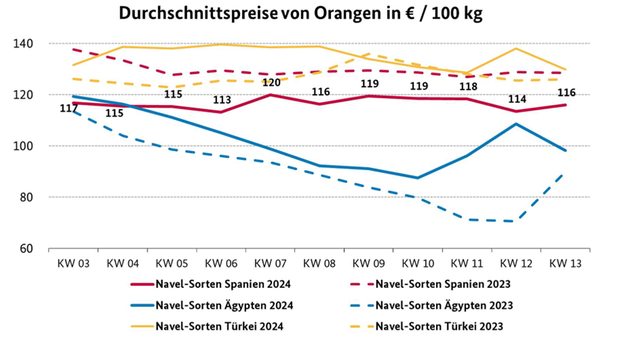Even as the season draws to a close, extensive offerings remain available, according to BLE. Spanish products continue to dominate the market. The presence of Egyptian Valencia Late and Salustiana oranges held firm, while Turkish Navel varieties saw a slight decrease. The Spanish supply of oranges shifted increasingly from Navelate to the late-season Lane Late variety. As the season progressed, demand began to wane, and with the slowing of goods turnover, pricing for both Egyptian and Spanish stocks had to be handled more flexibly here and there.
All in all, ratings changed little, as supplies were now being throttled back overall. In the blood orange segment, Italian Moros were still accessible. Spanish Cara Cara and Tarocco were scarcely available. As per the season, availability was somewhat restricted. Nonetheless, demand was easily satisfied. In Frankfurt, blood and regular oranges were almost exclusively purchased for juice production. Thus, sizes 4 to 6 sold well, while larger fruits remained.

Apples
Domestic products dominated the markets, with Elstar and Jonagold forming the basis of the assortment. Boskoop, Braeburn, and Royal Gala followed in importance. The wide range of domestic harvest fully stocked the markets.
Pears
South African shipments dominated, led by Abate Fetel, Williams Christ, Cheeky, Packham's Triumph, and Rosemarie. Argentine Williams Christ and Turkish Santa Maria and Devici supplemented with steady volumes. The Turkish varieties were comparatively long-lasting in the market this year.
Grapes
Locally, the Easter business fell short of expectations. An often cautious demand could not keep up with the extensive, predominantly South African, supplies. The selling prices for the dominant seedless varieties from South Africa tended to be weak.
Strawberries
Both in retail and on the wholesale markets, massively supplied batches from Andalusia dominated. The current quantities from Spain have grown significantly again, and accordingly, prices are very low. Greek, Italian, and Dutch shipments followed in quantity, all of which also intensified their imports.
Lemons
Demand was quite good and could be adequately satisfied; only Hamburg reported restrained sales due to the mild temperatures. Spain dominated with the established Primofiori variety.
Bananas
Business was satisfactory in many places despite seasonally limited intake. Although the demand for most brands could be met, prices often tended to rise slightly. In Hamburg, sales improved somewhat.
Cauliflower
France and Italy provided the bulk of the goods. Spanish shipments now supplemented the market more strongly again, indirectly lowering prices here and there. Belgian supplies were now available in Cologne and Frankfurt.
Lettuce
Lettuce primarily came from Belgium and Italy. Domestic batches from greenhouses increased, being very popular despite higher price levels. For mixed salads, Italian, French, and now increasingly domestic varieties were available.
Cucumbers
Domestic products significantly increased again and now shared the top spot in this segment with Dutch shipments. Belgian batches followed in terms of quantity.
Tomatoes
A wide assortment was available. Spain, Belgium, the Netherlands, and Turkey supplied TOVs, with Italy occasionally completing the selection. Regular tomatoes came in from Turkey, Morocco, and Spain. Cherry varieties were shared by Italians, Dutch, and Spaniards.
Bell peppers
Intensified imports from Spain continued to dominate the market scene. Vegetables from Turkey were supplementary, with green and occasionally red pointed varieties. The presence of Dutch and Belgian batches further expanded.
Asparagus
The markets were well supplied with domestic white and violet spears from mostly heated cultivation. The spring-like weather and the upcoming Easter holidays indeed spurred interest in asparagus, but since the harvest was still very regional and specific due to the heavy rains, white spears from domestic and Dutch cultivation were still offered at relatively high prices.
Source: BLE
